Subsea Filter Separators Market
Subsea Filter Separators Market Size and Share Forecast Outlook 2025 to 2035
The subsea filter separators market is projected to grow from USD 1.1 billion in 2025 to USD 1.7 billion by 2035, at a CAGR of 5.1%. Vertical Gas-Liquid will dominate with a 35.0% market share, while oil production will lead the application segment with a 45.0% share.
Subsea Filter Separators Market Forecast and Outlook 2025 to 2035
The subsea filter separators industry stands at the threshold of a decade-long expansion trajectory that promises to reshape specialty offshore processing applications, deepwater separation enhancement, and advanced subsea filtration solutions across oil production, gas processing, and specialty offshore sectors. The market's journey from USD 1,050.0 million in 2025 to USD 1,726.7 million by 2035 represents substantial growth,the market will rise at a CAGR of 5.1% which demonstrating the accelerating adoption of underwater separation systems and advanced offshore filtration solutions across oil operations, gas processing, and specialty subsea sectors.
The first half of the decade (2025-2030) will witness the market climbing from USD 1,050.0 million to approximately USD 1,279.9 million, adding USD 229.9 million in value, which constitutes 34% of the total forecast growth period. This phase will be characterized by the rapid adoption of vertical gas-liquid systems, driven by increasing demand for efficient subsea separation and the growing need for advanced underwater processing solutions worldwide. Advanced automation capabilities and flexible filtration systems will become standard expectations rather than premium options.
The latter half (2030-2035) will witness sustained growth from USD 1,279.9 million to USD 1,726.7 million, representing an addition of USD 446.8 million or 66% of the decade's expansion. This period will be defined by mass market penetration of specialized subsea filter technologies, integration with comprehensive offshore platforms, and seamless compatibility with existing subsea infrastructure. The market trajectory signals fundamental shifts in how producers approach subsea processing optimization and offshore separation quality management, with participants positioned to benefit from sustained demand across multiple application types and distribution segments.
The subsea filter separators market is further bolstered by technological innovations and increasing investments in deepwater oil and gas exploration. Emerging designs, such as compact modular separators, high-efficiency solids removal systems, and corrosion-resistant materials, are enabling operators to enhance operational uptime, reduce maintenance costs, and improve recovery rates in challenging offshore environments. Integration with digital monitoring platforms and real-time performance analytics is expected to become a key differentiator, allowing operators to optimize separation efficiency, predict maintenance cycles, and minimize operational risks.
Regionally, North America and the Middle East are anticipated to lead adoption due to well-established offshore production hubs and ongoing deepwater development projects, while Asia-Pacific, particularly Southeast Asia, is projected to witness rapid growth driven by expanding offshore drilling operations and increasing energy demand. Latin America and West Africa are emerging as attractive markets, supported by new offshore concessions and investment in subsea processing technologies.
Strategic collaborations, mergers, and technology partnerships between equipment manufacturers, oilfield service providers, and energy companies are expected to shape the competitive landscape. By 2035, the subsea filter separators industry is projected to evolve into a highly integrated, technology-driven ecosystem where efficiency, reliability, and environmental compliance converge, redefining offshore separation and filtration standards globally.
Quick Stats for Subsea Filter Separators Market
- Subsea Filter Separators Market Value (2025): USD 1,050.0 million
- Subsea Filter Separators Market Forecast Value (2035): USD 1,726.7 million
- Subsea Filter Separators Market Forecast CAGR: 5.1%
- Leading Separator Design in Subsea Filter Separators Market: Vertical Gas-Liquid
- Key Growth Regions in Subsea Filter Separators Market: North Sea/Europe, Gulf of Mexico/US, and APAC
- Top Key Players in Subsea Filter Separators Market: SLB OneSubsea, TechnipFMC, NOV, Halliburton, Baker Hughes
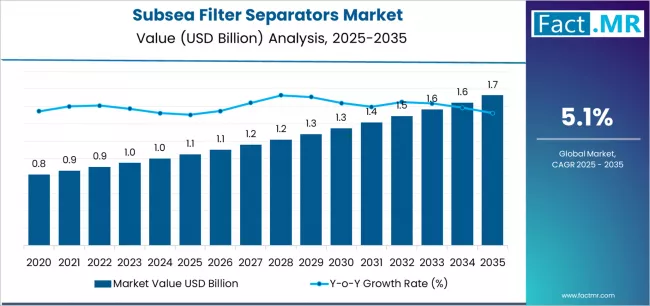
Subsea Filter Separators Market Year-over-Year Forecast 2025 to 2035
The Subsea Filter Separators market demonstrates distinct growth phases with varying market characteristics and competitive dynamics. Between 2025 and 2030, the market progresses through its subsea processing adoption phase, expanding from USD 1,050.0 million to USD 1,279.9 million with steady annual increments averaging 5.1% growth. This period showcases the transition from conventional surface separation to advanced subsea-based systems with enhanced processing capabilities and integrated quality control systems becoming mainstream features.
The 2025-2030 phase adds USD 229.9 million to market value, representing 34% of total decade expansion. Market maturation factors include standardization of subsea processing and offshore protocols, declining component costs for specialized separation equipment, and increasing industry awareness of underwater processing benefits reaching 95-98% separation effectiveness in oil and gas applications. Competitive landscape evolution during this period features established subsea companies like SLB OneSubsea and TechnipFMC expanding their separator portfolios while specialty manufacturers focus on advanced filtration development and enhanced processing capabilities.
From 2030 to 2035, market dynamics shift toward advanced subsea integration and global offshore distribution expansion, with growth continuing from USD 1,279.9 million to USD 1,726.7 million, adding USD 446.8 million or 66% of total expansion. This phase transition centers on specialized subsea filter systems, integration with automated offshore networks, and deployment across diverse oil, gas, and processing scenarios, becoming standard rather than specialized applications.
Subsea Filter Separators Market Key Takeaways
At-a-Glance Metrics
| Metric | Value |
|---|---|
| Market Value (2025) → | USD 1,050.0 million |
| Market Forecast (2035) ↑ | USD 1,726.7 million |
| Growth Rate ★ | 5.1% CAGR |
| Leading Separator Design → | Vertical Gas-Liquid |
| Primary Application → | Oil Production Segment |
The market demonstrates strong fundamentals with oil production applications capturing a dominant share through advanced separation processing and offshore enhancement capabilities. Vertical gas-liquid separators drive primary performance, supported by increasing subsea processing adoption and specialty offshore trends. Geographic expansion remains concentrated in established offshore regions with proven subsea infrastructure, while emerging economies show accelerating adoption rates driven by deepwater consciousness and rising subsea processing standards.
Why is the Subsea Filter Separators Market Growing?
Market expansion rests on three fundamental shifts driving adoption across the oil production, gas processing, and subsea operations sectors. First, subsea processing demand creates compelling operational advantages through subsea filter separators that provide immediate separation benefits without surface platform limitations, enabling operators to meet processing requirements while maintaining operational efficiency and reducing infrastructure costs. Second, deepwater development accelerates as specialty offshore facilities worldwide seek advanced separation systems that complement traditional surface processes, enabling precise filtration and quality control that align with industry standards and operational requirements.
Third, cost optimization drives adoption from offshore facilities and specialty operators requiring effective separation systems that maximize processing benefits while maintaining operational productivity during oil and gas production integration operations. However, growth faces headwinds from technical complexity considerations that vary across subsea suppliers regarding the sophistication of separation systems and installation requirements, which may limit adoption in technically challenging environments. Technical limitations also persist regarding system maintenance and subsea conditions that may reduce effectiveness in complex offshore environments, which affect separation performance and system reliability.
Opportunity Pathways - Subsea Filter Separators Market
The subsea filter separators market represents an offshore processing opportunity driven by expanding deepwater trends, subsea modernization, and the need for superior separation effectiveness in diverse underwater applications. As operators worldwide seek to achieve 95-98% separation effectiveness, reduce surface infrastructure, and integrate advanced subsea systems with offshore platforms, subsea filter separators are evolving from specialty equipment to sophisticated processing solutions ensuring efficiency and operational benefits.
The market's growth trajectory from USD 1,050.0 million in 2025 to USD 1,726.7 million by 2035 at a 5.1% CAGR reflects fundamental shifts in offshore preferences and subsea optimization. Geographic expansion opportunities are particularly pronounced in Asia Pacific markets, while the dominance of oil production applications (45.0% market share) and vertical gas-liquid separators (35.0% share) provides clear strategic focus areas.
Pathway A - Vertical Gas-Liquid Leadership & Advanced Separation Optimization
Strengthening the dominant vertical gas-liquid segment (35.0% market share) through enhanced separator formulations, superior separation content, and automated processing systems. This pathway focuses on optimizing separation efficiency, improving separator consistency, extending operational effectiveness to 95-98% success rates, and developing specialized formulations for diverse subsea applications. Market leadership consolidation through advanced separation engineering and integrated subsea systems enables premium positioning while defending competitive advantages against alternative separation systems. Expected revenue pool: USD 120-160 million
Pathway B - Oil Production Application Expansion & Market Localization
Rapid offshore development and oil production growth across global markets creates substantial expansion opportunities through specialized separation capabilities and energy partnerships. Growing subsea consciousness and processing efficiency trends drive sustained demand for advanced subsea filter systems. Application strategies reduce processing costs, enable superior separation performance, and position companies advantageously for energy programs while accessing growing offshore markets. Expected revenue pool: USD 154-206 million
Pathway C - North Sea/Europe Regional Dominance & Market Integration
Expansion within the dominant North Sea/Europe segment (35.0% market share) through specialized regional management addressing established offshore infrastructure and operational requirements. This pathway encompasses mature offshore systems, regional optimization, and compatibility with diverse subsea platforms. Premium positioning reflects superior regional expertise and comprehensive offshore compliance supporting modern subsea commerce. Expected revenue pool: USD 120-160 million
Pathway D - 25-100k bpd Capacity Diversification
Strategic expansion into 25-100k bpd capacity applications (45.0% market share) requires enhanced processing capabilities and specialized handling addressing medium-capacity operational requirements. This pathway addresses standard production applications, capacity integration, and advanced systems for demanding subsea conditions. Premium pricing reflects specialized performance requirements and capacity efficiency standards. Expected revenue pool: USD 154-206 million
Pathway E - Gas Processing Market Innovation
Development of specialized subsea filter applications for gas processing sector (35.0% share), addressing specific processing requirements and gas separation demands. This pathway encompasses gas-grade systems, processing applications, and cost-effective alternatives for gas markets. Technology differentiation through proprietary design enables diversified revenue streams while reducing dependency on single application platforms. Expected revenue pool: USD 120-160 million
Pathway F - Horizontal Two-Phase Development & Processing Integration
Expansion of horizontal two-phase segment (25.0% market share) through enhanced separation properties, dual-phase applications, and specialized processing requirements. This pathway encompasses two-phase development, horizontal applications, and processed systems requiring multi-phase characteristics. Market development through advanced separation engineering enables differentiated positioning while accessing markets requiring horizontal solutions. Expected revenue pool: USD 86-115 million
Pathway G - Gulf of Mexico/US Development & Regional Integration
Development of Gulf of Mexico/US applications addressing specialized regional requirements and offshore development across diverse subsea scenarios. This pathway encompasses regional systems, US market applications, and comprehensive subsea documentation. Premium positioning reflects regional expertise and development capabilities while enabling access to Gulf of Mexico programs and regionally-driven partnerships. Expected revenue pool: USD 86-115 million
Segmental Analysis
Primary Classification: The market segments by separator design into vertical gas-liquid, horizontal two-phase, coalescing cartridge, and cyclonic spin-tube categories, representing the evolution from traditional surface separation to specialized subsea solutions for comprehensive offshore optimization.
Secondary Classification: Application segmentation divides the market into Oil Production, Gas Processing, Water Injection, and Subsea Compression sectors, reflecting distinct requirements for separation performance, processing standards, and operational specifications.
Tertiary Classification: Capacity segmentation covers <25k bpd, 25-100k bpd, and >100k bpd categories, with medium-capacity systems leading adoption while high-capacity applications show accelerating growth patterns driven by production expansion programs.
By Separator Design, the Vertical Gas-Liquid Segment Accounts for Dominant Market Share
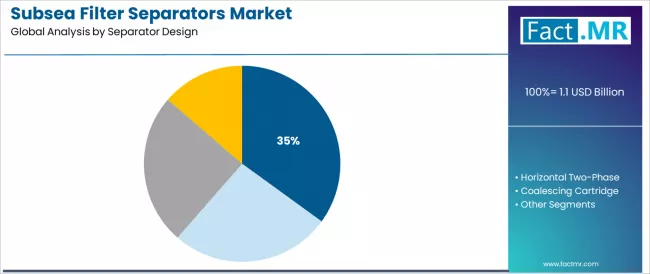
Market Position: Vertical gas-liquid separator systems command the leading position in the subsea filter separators market with approximately 35.0% market share through advanced separation features, including superior phase separation content, proven vertical capability, and system optimization that enable operators to achieve optimal processing benefits across diverse offshore and subsea environments.
Value Drivers: The segment benefits from operator preference for reliable separation systems that provide consistent phase separation performance, gravity separation optimization, and processing efficiency enhancement without requiring significant subsea modifications. Advanced vertical features enable automated separation systems, phase control, and integration with existing offshore equipment, where separation performance and system reliability represent critical operational requirements.
Competitive Advantages: Vertical gas-liquid systems differentiate through proven separation stability, consistent phase characteristics, and integration with automated subsea systems that enhance operational effectiveness while maintaining optimal quality suitable for diverse offshore and subsea applications.
Key market characteristics:
- Advanced separation formulations with optimized vertical mechanisms and phase separation capabilities
- Extended operational effectiveness, enabling 95-98% separation success with consistent processing quality
- Subsea compatibility, including automated control systems, separation monitoring, and process integration for offshore and subsea operations
Horizontal Two-Phase Shows Processing Growth
Horizontal two-phase systems maintain a significant 25.0% market share in the Subsea Filter Separators market due to their specialized dual-phase properties and versatile application advantages. These systems appeal to operators requiring high-quality separation with consistent characteristics for horizontal processing, dual-phase applications, and specialty subsea operations. Market growth is driven by offshore sector expansion, emphasizing reliable dual-phase separation solutions and operational efficiency through proven horizontal systems.
By Application, the Oil Production Segment Accounts for the Largest Market Share
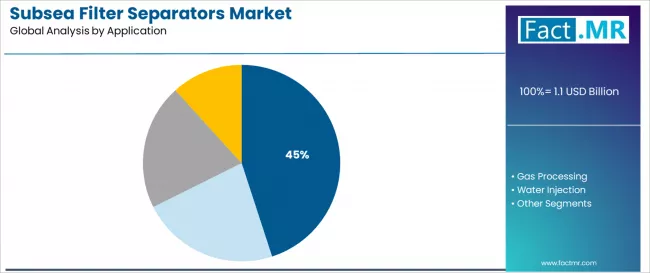
Market Context: Oil production applications dominate the subsea filter separators market with approximately 45.0% market share due to widespread adoption of oil processing platforms and increasing focus on production separation systems, oil quality optimization, and production enhancement applications that minimize traditional surface limitations while maintaining processing quality standards.
Appeal Factors: Oil operators prioritize production quality, separation efficiency, and integration with existing subsea infrastructure that enables coordinated processing across multiple production categories. The segment benefits from substantial oil production investment and modernization programs that emphasize the acquisition of advanced separation systems for quality improvement and processing efficiency applications.
Growth Drivers: Oil production trends incorporate subsea filter separators as essential equipment for production operations, while efficiency trends increase demand for advanced separation capabilities that comply with processing standards and minimize surface infrastructure.
Gas Processing Applications Demonstrate Strong Demand
Gas processing applications capture approximately 35.0% market share through specialized separation requirements in gas production, natural gas processing, and subsea applications. These facilities demand robust separation systems capable of operating in diverse gas conditions while providing effective phase separation and processing capabilities.
Water Injection Applications Show Operational Growth
Water injection applications account for approximately 15.0% market share, including enhanced oil recovery, water management, and injection applications requiring subsea filter capabilities for water quality management and injection optimization.
What are the Drivers, Restraints, and Key Trends of the Subsea Filter Separators Market?
Growth Accelerators: Deepwater development trends drive primary adoption as subsea filter separators provide advanced processing capabilities that enable offshore facilities to meet separation demands without surface platform limitations, supporting subsea operations and cost optimization missions that require underwater processing applications. Subsea processing consciousness accelerates market expansion as facilities seek effective separation systems that minimize surface infrastructure while maintaining operational effectiveness during oil and gas processing scenarios. Offshore spending increases worldwide, creating sustained demand for subsea filter systems that complement traditional surface processes and provide operational flexibility in complex subsea environments.
Growth Inhibitors: Technical complexity considerations vary across subsea suppliers regarding the sophistication of separation systems and installation requirements, which may limit operational flexibility and market penetration in regions with limited technical capacity or complexity-sensitive subsea operations. System maintenance limitations persist regarding service consistency and subsea conditions that may reduce effectiveness in deep water, high pressure, or demanding subsea conditions, affecting separation quality and system reliability. Market fragmentation across multiple separator specifications and application standards creates compatibility concerns between different suppliers and existing subsea infrastructure.
Market Evolution Patterns: Adoption accelerates in oil production and deepwater sectors where subsea processing requirements justify subsea filter separator investments, with geographic concentration in established offshore markets transitioning toward mainstream adoption in emerging subsea regions driven by deepwater consciousness expansion and subsea development. Technology development focuses on enhanced separation capabilities, improved system reliability, and integration with subsea systems that optimize processing effectiveness and operational performance.
Analysis of the Subsea Filter Separators Market by Key Country
The Subsea Filter Separators market demonstrates varied regional dynamics with Growth Leaders including China (6.3% CAGR) and Brazil (5.9% CAGR) driving expansion through subsea capacity additions and deepwater development programs. Steady Performers encompass United States (4.8% CAGR), United Kingdom (4.8% CAGR), and Germany (4.7% CAGR), benefiting from established offshore industries and advanced subsea adoption. Mature Markets feature South Korea (4.3% CAGR) and Japan (3.6% CAGR), where specialized applications and technology integration support consistent growth patterns.
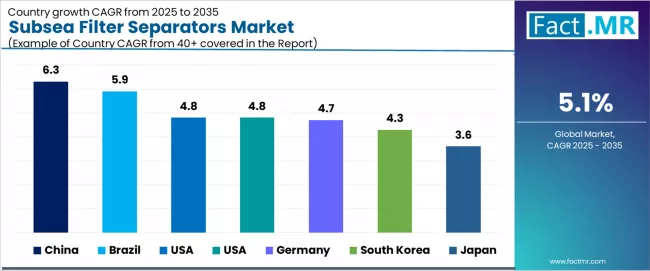
| Country | CAGR (2025-2035) |
|---|---|
| China | 6.3% |
| Brazil | 5.9% |
| United States | 4.8% |
| United Kingdom | 4.8% |
| Germany | 4.7% |
| South Korea | 4.3% |
| Japan | 3.6% |
China Demonstrates Technology Innovation
The Chinese market emphasizes advanced subsea features, including precision separation control and integration with comprehensive offshore development platforms that manage processing efficiency, cost optimization, and quality compliance applications through unified monitoring systems. The country demonstrates strong growth at 6.3% CAGR, driven by subsea modernization, deepwater initiative projects, and emerging processing applications that support subsea filter separator integration. Chinese operators prioritize operational effectiveness with subsea filter separators delivering consistent performance through advanced separation algorithms and offshore adaptation capabilities.
Technology deployment channels include major offshore development companies, specialized subsea suppliers, and energy procurement programs that support professional applications for complex subsea and deepwater applications. System integration capabilities with established offshore platforms expand market appeal across diverse operational requirements seeking separation efficiency and quality compliance benefits. The resilient offshore development sector and expanding deepwater capacity additions create sustained demand, while innovative applications in South China Sea development open new growth avenues.
Performance Metrics:
- Offshore development facilities in Tianjin, Shanghai, and Shenzhen leading adoption for automated separation operations
- Specialty subsea contractor channels maintaining 54% market share for complex offshore integration applications
- Commercial deepwater programs supporting 67% of system acquisitions across subsea and offshore facilities
- System compatibility with major offshore platforms driving procurement selection criteria
Brazil Emerges as High-Growth Market
Brazil leads growth momentum with a 5.9% CAGR, driven by rapid offshore industry modernization, expanding deepwater applications, and specialty subsea development adoption across major offshore regions including Santos Basin, Campos Basin, and Pre-Salt areas. Offshore industry development and subsea requirements drive primary demand, while growing deepwater processing and production sectors create diversified application opportunities. Government offshore industry initiatives and deepwater programs support sustained expansion. The convergence of offshore industry modernization, subsea processing growth, and deepwater capacity expansion positions Brazil as a key emerging market for subsea filter systems.
Strategic Market Indicators:
- Government support for offshore industry development and deepwater expansion driving demand for specialty subsea filter processing throughout major offshore regions and deepwater clusters across subsea facilities, offshore centers, and deepwater production centers
- Strong offshore sector growth and expanding network of subsea facilities supporting rapid adoption of subsea filter technologies among operators seeking enhanced separation efficiency and premium offshore offerings
United States Demonstrates Advanced Integration
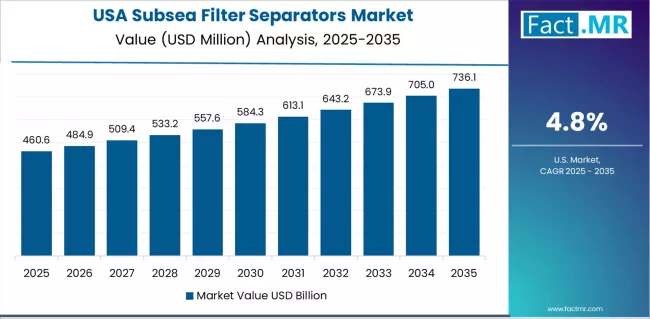
The US market holds steady growth at 4.8% CAGR, driven by subsea processing modernization activities, specialty offshore programs, and advanced separation adoption trends. American offshore facilities and energy companies are implementing advanced subsea filter systems to enhance processing capabilities and support subsea operations that align with MMS regulations and safety standards. Market expansion benefits from offshore energy programs that emphasize advanced separation capabilities in specialty subsea and deepwater specifications, creating sustained demand where operational flexibility and system compliance represent critical requirements.
Strategic Market Indicators:
- Subsea processing and offshore facilities leading adoption with modernization programs requiring advanced separation systems
- MMS safety programs providing support for advanced separation system acquisition
- Specialty offshore compliance requirements driving demand for standardized systems with operational compatibility
- Specialized deepwater and premium offshore segments adopting comprehensive separation solutions for subsea optimization
United Kingdom Drives Subsea Integration
The UK market holds steady growth at 4.8% CAGR, driven by subsea processing modernization activities, specialty offshore programs, and advanced separation adoption trends. British offshore facilities and energy companies are implementing advanced subsea filter systems to enhance processing capabilities and support subsea operations that align with HSE regulations and safety standards. Market expansion benefits from offshore safety programs that mandate advanced separation capabilities in specialty subsea and offshore specifications, creating sustained demand where operational flexibility and system compliance represent critical requirements.
Strategic Market Indicators:
- Subsea processing and offshore facilities leading adoption with modernization programs requiring advanced separation systems
- HSE safety programs providing regulatory support for advanced separation system acquisition
- Specialty offshore compliance requirements driving demand for standardized systems with international operational compatibility
- Specialized deepwater and premium offshore segments adopting comprehensive separation solutions for subsea optimization
Germany Emphasizes Advanced Processing Integration
Germany demonstrates robust market development with a 4.7% CAGR, distinguished by offshore companies and specialty energy producers' preference for high-quality subsea filter systems that integrate seamlessly with existing subsea systems and provide reliable long-term operation in specialized separation applications. The market prioritizes advanced features, including precision separation control, system durability, and integration with comprehensive subsea platforms that reflect German industry expectations for technological sophistication and operational excellence.
Growth drivers encompass advanced renewable energy applications, expanding offshore modernization requirements, and separation system integration. German operators emphasize quality control systems and comprehensive technical support that align with domestic offshore industry standards. The convergence of high-tech offshore processing, specialty subsea innovation, and growing renewable production creates diversified demand across multiple application segments.
Market Characteristics:
- Premium focus on renewable energy systems with advanced separation algorithms and precision subsea capabilities
- Integration requirements with existing offshore processing and specialty subsea platforms
- Emphasis on operational reliability and long-term durability in offshore and subsea applications
South Korea Emphasizes Technology Integration
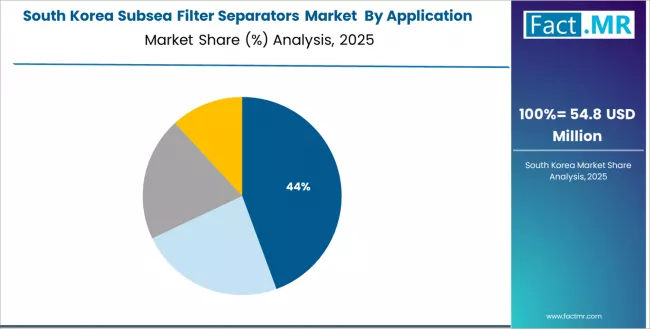
South Korea demonstrates robust market development with a 4.3% CAGR, distinguished by offshore companies and specialty marine producers' preference for high-quality subsea filter systems that integrate seamlessly with existing offshore systems and provide reliable long-term operation in specialized separation applications. The market prioritizes advanced features, including precision separation control, system durability, and integration with comprehensive offshore platforms that reflect Korean industry expectations for technological sophistication and operational excellence.
Growth drivers encompass advanced shipbuilding applications, expanding offshore modernization requirements, and separation system integration. Korean operators emphasize quality control systems and comprehensive technical support that align with domestic marine industry standards. The convergence of high-tech shipbuilding, specialty offshore innovation, and growing marine production creates diversified demand across multiple application segments.
Market Characteristics:
- Premium focus on shipbuilding systems with advanced separation algorithms and precision marine capabilities
- Integration requirements with existing offshore processing and specialty marine platforms
- Emphasis on operational reliability and long-term durability in offshore and marine applications
Japan Emphasizes Precision and Processing Excellence
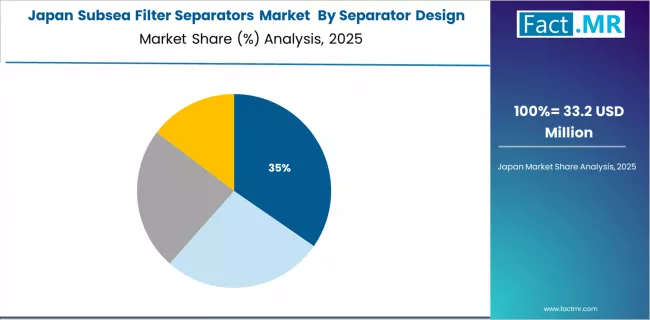
Japan demonstrates steady market development with a 3.6% CAGR, distinguished by offshore manufacturing and specialty energy producers' preference for high-quality subsea filter systems that integrate seamlessly with existing offshore systems and provide reliable long-term operation in specialized separation applications. The market prioritizes advanced features, including precision separation control, system durability, and integration with comprehensive offshore platforms that reflect Japanese industry expectations for technological sophistication and operational excellence.
High-specification offshore manufacturing and specialty energy applications drive demand, supported by advanced separation research and development initiatives. Japanese operators emphasize subsea filter reliability, consistent performance characteristics, and comprehensive quality documentation that aligns with stringent offshore industry standards. The focus on premium applications and technical excellence supports stable growth despite mature market conditions.
Market Characteristics:
- Premium focus on offshore systems with advanced separation algorithms and precision subsea capabilities
- Integration requirements with existing offshore processing and specialty energy platforms
- Emphasis on operational reliability and long-term durability in offshore and subsea applications
Europe Market Split by Country
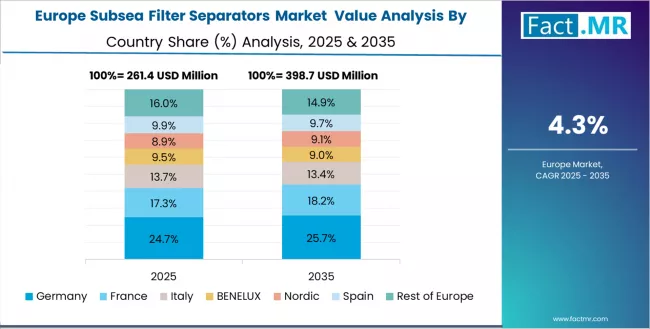
The European Subsea Filter Separators market is projected to grow from USD 415.0 million in 2025 to USD 620.0 million by 2035, registering a CAGR of 4.9% over the forecast period. United Kingdom is expected to maintain its leadership position with a 29.6% market share in 2025, declining slightly to 29.1% by 2035, supported by its advanced offshore infrastructure and major subsea centers in North Sea operations.
Norway follows with a 26.3% share in 2025, projected to reach 26.8% by 2035, driven by comprehensive offshore modernization programs and specialty subsea initiatives. Germany holds a 16.1% share in 2025, expected to moderate to 15.7% by 2035 through specialized offshore activities and subsea applications. Netherlands commands a 11.4% share in 2025, rising to 11.8% by 2035 through strong offshore and subsea projects. France accounts for 8.2% in 2025, reaching 8.5% by 2035 aided by offshore modernization and subsea applications. Denmark maintains a 4.3% share in 2025, increasing to 4.5% by 2035 driven by specialty offshore and innovation demand. The Rest of Europe region is anticipated to hold 4.1% in 2025, increasing to 3.6% by 2035, reflecting steady adoption in other European offshore regions.
Oil Production Dominates Demand in Japan
In Japan, the Subsea Filter Separators market prioritizes oil production systems, which capture the dominant share of offshore and specialty subsea installations due to their advanced features, including precision separation optimization and seamless integration with existing offshore infrastructure. Japanese offshore operators emphasize reliability, precision, and long-term operational excellence, creating demand for oil production systems that provide consistent subsea filter capabilities and adaptive performance based on separation requirements and subsea conditions.
Processing Companies Lead Subsea Services in South Korea
In South Korea, the market structure favors international processing companies, including SLB OneSubsea, TechnipFMC, and NOV, which maintain dominant positions through comprehensive product portfolios and established offshore industry networks supporting both oil production and gas processing installations. These providers offer integrated solutions combining advanced subsea filter systems with professional application services and ongoing technical support that appeal to Korean operators seeking reliable subsea separation systems.
Competitive Landscape of the Subsea Filter Separators Market
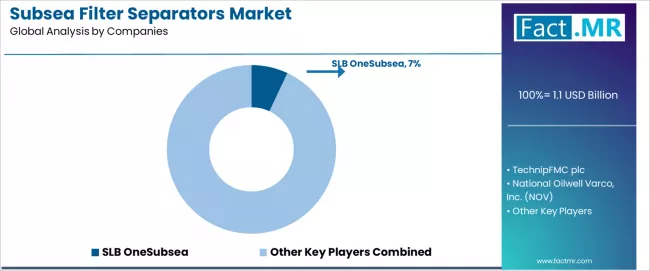
The subsea filter separators market operates with moderate concentration, featuring approximately 12-15 meaningful participants, where leading companies control roughly 31-38% of the global market share through established offshore industry relationships and comprehensive subsea technology portfolios. Competition emphasizes advanced separation capabilities, system reliability, and subsea integration rather than price-based rivalry. The leading company, SLB OneSubsea, commands approximately 7.0% market share through its specialized subsea expertise and extensive oil and gas processing industry presence.
Market Leaders encompass SLB OneSubsea, TechnipFMC, and NOV, which maintain competitive advantages through extensive subsea engineering expertise, global offshore networks, and comprehensive system integration capabilities that create customer switching costs and support premium pricing. These companies leverage years of subsea technology experience and ongoing research investments to develop advanced subsea filter systems with precision separation control and offshore monitoring features.
Technology Innovators include Halliburton, Baker Hughes, and Aker Solutions, which compete through specialized subsea technology focus and innovative separation interfaces that appeal to operators seeking advanced processing capabilities and operational flexibility. These companies differentiate through rapid development cycles and specialized offshore and subsea application focus. Regional Specialists feature companies like Dril-Quip, Cameron, MODEC, and Oceaneering, which focus on specific geographic markets and specialized applications. Market dynamics favor participants that combine reliable separation capabilities with advanced subsea systems, including precision processing control and automatic performance optimization capabilities.
Key Players in the Subsea Filter Separators Market
- SLB OneSubsea
- TechnipFMC plc
- National Oilwell Varco, Inc. (NOV)
- Halliburton Company
- Baker Hughes Company
- Aker Solutions ASA
- Dril-Quip, Inc.
- Cameron International Corporation (a Schlumberger company)
- MODEC, Inc.
- Oceaneering International, Inc.
Scope of the Report
| Item | Value |
|---|---|
| Quantitative Units | USD Million |
| Separator Design | Vertical Gas-Liquid, Horizontal Two-Phase, Coalescing Cartridge, Cyclonic Spin-Tube |
| Application | Oil Production, Gas Processing, Water Injection, Subsea Compression |
| Capacity | <25k bpd, 25-100k bpd, >100k bpd |
| Region Split | North Sea/Europe, Gulf of Mexico/US, APAC, Other |
| Regions Covered | North America, Europe, Asia Pacific, Latin America, Middle East & Africa |
| Countries Covered | United States, Germany, United Kingdom, China, Japan, South Korea, Brazil, and 15+ additional countries |
| Key Companies Profiled | SLB OneSubsea, TechnipFMC, NOV, Halliburton, Baker Hughes, Aker Solutions, Dril-Quip |
| Additional Attributes | Dollar sales by separator design and application categories, regional adoption trends across North Sea/Europe, Gulf of Mexico/US, and APAC, competitive landscape with subsea processors and offshore suppliers, operator preferences for separation capabilities and system reliability, integration with offshore platforms and quality monitoring systems, innovations in vertical gas-liquid processing and subsea compliance, and development of automated separation solutions with enhanced performance and offshore optimization capabilities. |
Subsea Filter Separators Market by Segments
-
Separator Design :
- Vertical Gas-Liquid
- Horizontal Two-Phase
- Coalescing Cartridge
- Cyclonic Spin-Tube
-
Application :
- Oil Production
- Gas Processing
- Water Injection
- Subsea Compression
-
Capacity :
- <25k bpd
- 25-100k bpd
- 100k bpd
-
Region Split :
- North Sea/Europe
- Gulf of Mexico/US
- APAC
- Other
-
Region :
- North America
- United States
- Canada
- Mexico
- Europe
- Germany
- France
- United Kingdom
- Italy
- Spain
- Netherlands
- Nordic
- Rest of Europe
- Asia Pacific
- Japan
- South Korea
- China
- India
- ASEAN
- Australia & New Zealand
- Rest of Asia Pacific
- Latin America
- Brazil
- Argentina
- Rest of Latin America
- Middle East & Africa
- GCC Countries
- South Africa
- Rest of Middle East & Africa
- North America
Table of Content
- Executive Summary
- Global Market Outlook
- Demand to side Trends
- Supply to side Trends
- Technology Roadmap Analysis
- Analysis and Recommendations
- Market Overview
- Market Coverage / Taxonomy
- Market Definition / Scope / Limitations
- Market Background
- Market Dynamics
- Drivers
- Restraints
- Opportunity
- Trends
- Scenario Forecast
- Demand in Optimistic Scenario
- Demand in Likely Scenario
- Demand in Conservative Scenario
- Opportunity Map Analysis
- Product Life Cycle Analysis
- Supply Chain Analysis
- Investment Feasibility Matrix
- Value Chain Analysis
- PESTLE and Porter’s Analysis
- Regulatory Landscape
- Regional Parent Market Outlook
- Production and Consumption Statistics
- Import and Export Statistics
- Market Dynamics
- Global Market Analysis 2020 to 2024 and Forecast, 2025 to 2035
- Historical Market Size Value (USD Million) Analysis, 2020 to 2024
- Current and Future Market Size Value (USD Million) Projections, 2025 to 2035
- Y to o to Y Growth Trend Analysis
- Absolute $ Opportunity Analysis
- Global Market Pricing Analysis 2020 to 2024 and Forecast 2025 to 2035
- Global Market Analysis 2020 to 2024 and Forecast 2025 to 2035, By Separator Design
- Introduction / Key Findings
- Historical Market Size Value (USD Million) Analysis By Separator Design , 2020 to 2024
- Current and Future Market Size Value (USD Million) Analysis and Forecast By Separator Design , 2025 to 2035
- Vertical Gas-Liquid
- Horizontal Two-Phase
- Coalescing Cartridge
- Cyclonic Spin-Tube
- Y to o to Y Growth Trend Analysis By Separator Design , 2020 to 2024
- Absolute $ Opportunity Analysis By Separator Design , 2025 to 2035
- Global Market Analysis 2020 to 2024 and Forecast 2025 to 2035, By Application
- Introduction / Key Findings
- Historical Market Size Value (USD Million) Analysis By Application, 2020 to 2024
- Current and Future Market Size Value (USD Million) Analysis and Forecast By Application, 2025 to 2035
- Oil Production
- Gas Processing
- Water Injection
- Subsea Compression
- Y to o to Y Growth Trend Analysis By Application, 2020 to 2024
- Absolute $ Opportunity Analysis By Application, 2025 to 2035
- Global Market Analysis 2020 to 2024 and Forecast 2025 to 2035, By Region
- Introduction
- Historical Market Size Value (USD Million) Analysis By Region, 2020 to 2024
- Current Market Size Value (USD Million) Analysis and Forecast By Region, 2025 to 2035
- North America
- Latin America
- Western Europe
- Eastern Europe
- East Asia
- South Asia and Pacific
- Middle East & Africa
- Market Attractiveness Analysis By Region
- North America Market Analysis 2020 to 2024 and Forecast 2025 to 2035, By Country
- Historical Market Size Value (USD Million) Trend Analysis By Market Taxonomy, 2020 to 2024
- Market Size Value (USD Million) Forecast By Market Taxonomy, 2025 to 2035
- By Country
- USA
- Canada
- Mexico
- By Separator Design
- By Application
- By Country
- Market Attractiveness Analysis
- By Country
- By Separator Design
- By Application
- Key Takeaways
- Latin America Market Analysis 2020 to 2024 and Forecast 2025 to 2035, By Country
- Historical Market Size Value (USD Million) Trend Analysis By Market Taxonomy, 2020 to 2024
- Market Size Value (USD Million) Forecast By Market Taxonomy, 2025 to 2035
- By Country
- Brazil
- Chile
- Rest of Latin America
- By Separator Design
- By Application
- By Country
- Market Attractiveness Analysis
- By Country
- By Separator Design
- By Application
- Key Takeaways
- Western Europe Market Analysis 2020 to 2024 and Forecast 2025 to 2035, By Country
- Historical Market Size Value (USD Million) Trend Analysis By Market Taxonomy, 2020 to 2024
- Market Size Value (USD Million) Forecast By Market Taxonomy, 2025 to 2035
- By Country
- Germany
- UK
- Italy
- Spain
- France
- Nordic
- BENELUX
- Rest of Western Europe
- By Separator Design
- By Application
- By Country
- Market Attractiveness Analysis
- By Country
- By Separator Design
- By Application
- Key Takeaways
- Eastern Europe Market Analysis 2020 to 2024 and Forecast 2025 to 2035, By Country
- Historical Market Size Value (USD Million) Trend Analysis By Market Taxonomy, 2020 to 2024
- Market Size Value (USD Million) Forecast By Market Taxonomy, 2025 to 2035
- By Country
- Russia
- Poland
- Hungary
- Balkan & Baltic
- Rest of Eastern Europe
- By Separator Design
- By Application
- By Country
- Market Attractiveness Analysis
- By Country
- By Separator Design
- By Application
- Key Takeaways
- East Asia Market Analysis 2020 to 2024 and Forecast 2025 to 2035, By Country
- Historical Market Size Value (USD Million) Trend Analysis By Market Taxonomy, 2020 to 2024
- Market Size Value (USD Million) Forecast By Market Taxonomy, 2025 to 2035
- By Country
- China
- Japan
- South Korea
- By Separator Design
- By Application
- By Country
- Market Attractiveness Analysis
- By Country
- By Separator Design
- By Application
- Key Takeaways
- South Asia and Pacific Market Analysis 2020 to 2024 and Forecast 2025 to 2035, By Country
- Historical Market Size Value (USD Million) Trend Analysis By Market Taxonomy, 2020 to 2024
- Market Size Value (USD Million) Forecast By Market Taxonomy, 2025 to 2035
- By Country
- India
- ASEAN
- Australia & New Zealand
- Rest of South Asia and Pacific
- By Separator Design
- By Application
- By Country
- Market Attractiveness Analysis
- By Country
- By Separator Design
- By Application
- Key Takeaways
- Middle East & Africa Market Analysis 2020 to 2024 and Forecast 2025 to 2035, By Country
- Historical Market Size Value (USD Million) Trend Analysis By Market Taxonomy, 2020 to 2024
- Market Size Value (USD Million) Forecast By Market Taxonomy, 2025 to 2035
- By Country
- Kingdom of Saudi Arabia
- Other GCC Countries
- Turkiye
- South Africa
- Other African Union
- Rest of Middle East & Africa
- By Separator Design
- By Application
- By Country
- Market Attractiveness Analysis
- By Country
- By Separator Design
- By Application
- Key Takeaways
- Key Countries Market Analysis
- USA
- Pricing Analysis
- Market Share Analysis, 2024
- By Separator Design
- By Application
- Canada
- Pricing Analysis
- Market Share Analysis, 2024
- By Separator Design
- By Application
- Mexico
- Pricing Analysis
- Market Share Analysis, 2024
- By Separator Design
- By Application
- Brazil
- Pricing Analysis
- Market Share Analysis, 2024
- By Separator Design
- By Application
- Chile
- Pricing Analysis
- Market Share Analysis, 2024
- By Separator Design
- By Application
- Germany
- Pricing Analysis
- Market Share Analysis, 2024
- By Separator Design
- By Application
- UK
- Pricing Analysis
- Market Share Analysis, 2024
- By Separator Design
- By Application
- Italy
- Pricing Analysis
- Market Share Analysis, 2024
- By Separator Design
- By Application
- Spain
- Pricing Analysis
- Market Share Analysis, 2024
- By Separator Design
- By Application
- France
- Pricing Analysis
- Market Share Analysis, 2024
- By Separator Design
- By Application
- India
- Pricing Analysis
- Market Share Analysis, 2024
- By Separator Design
- By Application
- ASEAN
- Pricing Analysis
- Market Share Analysis, 2024
- By Separator Design
- By Application
- Australia & New Zealand
- Pricing Analysis
- Market Share Analysis, 2024
- By Separator Design
- By Application
- China
- Pricing Analysis
- Market Share Analysis, 2024
- By Separator Design
- By Application
- Japan
- Pricing Analysis
- Market Share Analysis, 2024
- By Separator Design
- By Application
- South Korea
- Pricing Analysis
- Market Share Analysis, 2024
- By Separator Design
- By Application
- Russia
- Pricing Analysis
- Market Share Analysis, 2024
- By Separator Design
- By Application
- Poland
- Pricing Analysis
- Market Share Analysis, 2024
- By Separator Design
- By Application
- Hungary
- Pricing Analysis
- Market Share Analysis, 2024
- By Separator Design
- By Application
- Kingdom of Saudi Arabia
- Pricing Analysis
- Market Share Analysis, 2024
- By Separator Design
- By Application
- Turkiye
- Pricing Analysis
- Market Share Analysis, 2024
- By Separator Design
- By Application
- South Africa
- Pricing Analysis
- Market Share Analysis, 2024
- By Separator Design
- By Application
- USA
- Market Structure Analysis
- Competition Dashboard
- Competition Benchmarking
- Market Share Analysis of Top Players
- By Regional
- By Separator Design
- By Application
- Competition Analysis
- Competition Deep Dive
- SLB OneSubsea
- Overview
- Product Portfolio
- Profitability by Market Segments (Product/Age /Sales Channel/Region)
- Sales Footprint
- Strategy Overview
- Marketing Strategy
- Product Strategy
- Channel Strategy
- TechnipFMC plc
- National Oilwell Varco, Inc. (NOV)
- Halliburton Company
- Baker Hughes Company
- Aker Solutions ASA
- Dril-Quip, Inc.
- Cameron International Corporation (a Schlumberger company)
- MODEC, Inc.
- Oceaneering International, Inc.
- SLB OneSubsea
- Competition Deep Dive
- Assumptions & Acronyms Used
- Research Methodology
List Of Table
- Table 1: Global Market Value (USD Million) Forecast by Region, 2020 to 2035
- Table 2: Global Market Value (USD Million) Forecast by Separator Design , 2020 to 2035
- Table 3: Global Market Value (USD Million) Forecast by Application, 2020 to 2035
- Table 4: North America Market Value (USD Million) Forecast by Country, 2020 to 2035
- Table 5: North America Market Value (USD Million) Forecast by Separator Design , 2020 to 2035
- Table 6: North America Market Value (USD Million) Forecast by Application, 2020 to 2035
- Table 7: Latin America Market Value (USD Million) Forecast by Country, 2020 to 2035
- Table 8: Latin America Market Value (USD Million) Forecast by Separator Design , 2020 to 2035
- Table 9: Latin America Market Value (USD Million) Forecast by Application, 2020 to 2035
- Table 10: Western Europe Market Value (USD Million) Forecast by Country, 2020 to 2035
- Table 11: Western Europe Market Value (USD Million) Forecast by Separator Design , 2020 to 2035
- Table 12: Western Europe Market Value (USD Million) Forecast by Application, 2020 to 2035
- Table 13: Eastern Europe Market Value (USD Million) Forecast by Country, 2020 to 2035
- Table 14: Eastern Europe Market Value (USD Million) Forecast by Separator Design , 2020 to 2035
- Table 15: Eastern Europe Market Value (USD Million) Forecast by Application, 2020 to 2035
- Table 16: East Asia Market Value (USD Million) Forecast by Country, 2020 to 2035
- Table 17: East Asia Market Value (USD Million) Forecast by Separator Design , 2020 to 2035
- Table 18: East Asia Market Value (USD Million) Forecast by Application, 2020 to 2035
- Table 19: South Asia and Pacific Market Value (USD Million) Forecast by Country, 2020 to 2035
- Table 20: South Asia and Pacific Market Value (USD Million) Forecast by Separator Design , 2020 to 2035
- Table 21: South Asia and Pacific Market Value (USD Million) Forecast by Application, 2020 to 2035
- Table 22: Middle East & Africa Market Value (USD Million) Forecast by Country, 2020 to 2035
- Table 23: Middle East & Africa Market Value (USD Million) Forecast by Separator Design , 2020 to 2035
- Table 24: Middle East & Africa Market Value (USD Million) Forecast by Application, 2020 to 2035
List Of Figures
- Figure 1: Global Market Pricing Analysis
- Figure 2: Global Market Value (USD Million) Forecast 2020-2035
- Figure 3: Global Market Value Share and BPS Analysis by Separator Design , 2025 and 2035
- Figure 4: Global Market Y to o to Y Growth Comparison by Separator Design , 2025-2035
- Figure 5: Global Market Attractiveness Analysis by Separator Design
- Figure 6: Global Market Value Share and BPS Analysis by Application, 2025 and 2035
- Figure 7: Global Market Y to o to Y Growth Comparison by Application, 2025-2035
- Figure 8: Global Market Attractiveness Analysis by Application
- Figure 9: Global Market Value (USD Million) Share and BPS Analysis by Region, 2025 and 2035
- Figure 10: Global Market Y to o to Y Growth Comparison by Region, 2025-2035
- Figure 11: Global Market Attractiveness Analysis by Region
- Figure 12: North America Market Incremental Dollar Opportunity, 2025-2035
- Figure 13: Latin America Market Incremental Dollar Opportunity, 2025-2035
- Figure 14: Western Europe Market Incremental Dollar Opportunity, 2025-2035
- Figure 15: Eastern Europe Market Incremental Dollar Opportunity, 2025-2035
- Figure 16: East Asia Market Incremental Dollar Opportunity, 2025-2035
- Figure 17: South Asia and Pacific Market Incremental Dollar Opportunity, 2025-2035
- Figure 18: Middle East & Africa Market Incremental Dollar Opportunity, 2025-2035
- Figure 19: North America Market Value Share and BPS Analysis by Country, 2025 and 2035
- Figure 20: North America Market Value Share and BPS Analysis by Separator Design , 2025 and 2035
- Figure 21: North America Market Y to o to Y Growth Comparison by Separator Design , 2025-2035
- Figure 22: North America Market Attractiveness Analysis by Separator Design
- Figure 23: North America Market Value Share and BPS Analysis by Application, 2025 and 2035
- Figure 24: North America Market Y to o to Y Growth Comparison by Application, 2025-2035
- Figure 25: North America Market Attractiveness Analysis by Application
- Figure 26: Latin America Market Value Share and BPS Analysis by Country, 2025 and 2035
- Figure 27: Latin America Market Value Share and BPS Analysis by Separator Design , 2025 and 2035
- Figure 28: Latin America Market Y to o to Y Growth Comparison by Separator Design , 2025-2035
- Figure 29: Latin America Market Attractiveness Analysis by Separator Design
- Figure 30: Latin America Market Value Share and BPS Analysis by Application, 2025 and 2035
- Figure 31: Latin America Market Y to o to Y Growth Comparison by Application, 2025-2035
- Figure 32: Latin America Market Attractiveness Analysis by Application
- Figure 33: Western Europe Market Value Share and BPS Analysis by Country, 2025 and 2035
- Figure 34: Western Europe Market Value Share and BPS Analysis by Separator Design , 2025 and 2035
- Figure 35: Western Europe Market Y to o to Y Growth Comparison by Separator Design , 2025-2035
- Figure 36: Western Europe Market Attractiveness Analysis by Separator Design
- Figure 37: Western Europe Market Value Share and BPS Analysis by Application, 2025 and 2035
- Figure 38: Western Europe Market Y to o to Y Growth Comparison by Application, 2025-2035
- Figure 39: Western Europe Market Attractiveness Analysis by Application
- Figure 40: Eastern Europe Market Value Share and BPS Analysis by Country, 2025 and 2035
- Figure 41: Eastern Europe Market Value Share and BPS Analysis by Separator Design , 2025 and 2035
- Figure 42: Eastern Europe Market Y to o to Y Growth Comparison by Separator Design , 2025-2035
- Figure 43: Eastern Europe Market Attractiveness Analysis by Separator Design
- Figure 44: Eastern Europe Market Value Share and BPS Analysis by Application, 2025 and 2035
- Figure 45: Eastern Europe Market Y to o to Y Growth Comparison by Application, 2025-2035
- Figure 46: Eastern Europe Market Attractiveness Analysis by Application
- Figure 47: East Asia Market Value Share and BPS Analysis by Country, 2025 and 2035
- Figure 48: East Asia Market Value Share and BPS Analysis by Separator Design , 2025 and 2035
- Figure 49: East Asia Market Y to o to Y Growth Comparison by Separator Design , 2025-2035
- Figure 50: East Asia Market Attractiveness Analysis by Separator Design
- Figure 51: East Asia Market Value Share and BPS Analysis by Application, 2025 and 2035
- Figure 52: East Asia Market Y to o to Y Growth Comparison by Application, 2025-2035
- Figure 53: East Asia Market Attractiveness Analysis by Application
- Figure 54: South Asia and Pacific Market Value Share and BPS Analysis by Country, 2025 and 2035
- Figure 55: South Asia and Pacific Market Value Share and BPS Analysis by Separator Design , 2025 and 2035
- Figure 56: South Asia and Pacific Market Y to o to Y Growth Comparison by Separator Design , 2025-2035
- Figure 57: South Asia and Pacific Market Attractiveness Analysis by Separator Design
- Figure 58: South Asia and Pacific Market Value Share and BPS Analysis by Application, 2025 and 2035
- Figure 59: South Asia and Pacific Market Y to o to Y Growth Comparison by Application, 2025-2035
- Figure 60: South Asia and Pacific Market Attractiveness Analysis by Application
- Figure 61: Middle East & Africa Market Value Share and BPS Analysis by Country, 2025 and 2035
- Figure 62: Middle East & Africa Market Value Share and BPS Analysis by Separator Design , 2025 and 2035
- Figure 63: Middle East & Africa Market Y to o to Y Growth Comparison by Separator Design , 2025-2035
- Figure 64: Middle East & Africa Market Attractiveness Analysis by Separator Design
- Figure 65: Middle East & Africa Market Value Share and BPS Analysis by Application, 2025 and 2035
- Figure 66: Middle East & Africa Market Y to o to Y Growth Comparison by Application, 2025-2035
- Figure 67: Middle East & Africa Market Attractiveness Analysis by Application
- Figure 68: Global Market - Tier Structure Analysis
- Figure 69: Global Market - Company Share Analysis
- FAQs -
How big is the subsea filter separators market in 2025?
The global subsea filter separators market is estimated to be valued at USD 1.1 billion in 2025.
What will be the size of subsea filter separators market in 2035?
The market size for the subsea filter separators market is projected to reach USD 1.7 billion by 2035.
How much will be the subsea filter separators market growth between 2025 and 2035?
The subsea filter separators market is expected to grow at a 5.1?GR between 2025 and 2035.
What are the key product types in the subsea filter separators market ?
The key product types in subsea filter separators market are vertical gas-liquid, horizontal two-phase, coalescing cartridge and cyclonic spin-tube.
Which application segment to contribute significant share in the subsea filter separators market in 2025?
In terms of application, oil production segment to command 45.0% share in the subsea filter separators market in 2025.